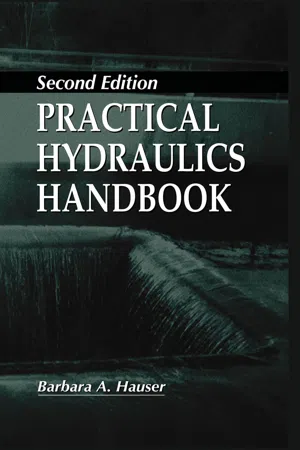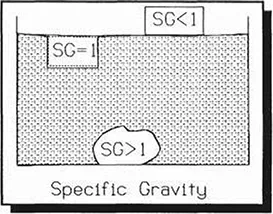
- 368 pages
- English
- ePUB (mobile friendly)
- Available on iOS & Android
Practical Hydraulics Handbook
About This Book
The Second Edition of the Practical Hydraulics Handbook is a must for all those who work with water utility systems. Presented in workbook format and emphasizing practical applications, this Handbook is perfect for hydraulic engineers, technicians, operating personnel, supervisors, managers, consultants, and students.
The exceptionally well-organized chapters include information on pressurized systems and open channel flow, principles of energy and force, flow calculations and measurement, pumps, and pumping applications.
This latest edition of the Practical Hydraulics Handbook includes new exercises at the end of each chapter and detailed solutions to selected exercises. The well-chosen exercises allow readers to practice applications of the theory and to test their knowledge of the material. The solutions provide guidance and problem-solving techniques that can be used both in the field and in the lab. Reference tables are also provided for calculations of friction loss, velocity, pipe fullness, well drawdown, English/metric conversions, power, and metered flow. These tables make calculations easier and minimize the chance for error.
In this new edition of Practical Hydraulics Handbook, all of the major principles and calculations dealing with the hydraulics of water systems are covered, and new and expanded material has been added.
Frequently asked questions
Information
Chapter 1
Mass, Density and Displacement
mass & weight
density
temperature
pressure
specific gravity

displacement
buoyancy
Problems
- The water in a tank weighs 820 pounds. How many gallons does it hold?
- If the municipal water rate is one dollar per thousand gallons, how many pounds of water are delivered to the customer’s house - for a dollar?
- Three cubic feet of gasoline weighs 131 lb.
- What is the Specific Gravity of gasoline?
- How much does a gallon of it weigh?
- If an oil weighs 55 lb./cu.ft., how much does a five gallon can of it weigh?
- The Specific Gravity of a liquid chemical is 1.27. What is its density (lb./cu.ft.)?
- A truck is designed to transport 5000 gallons of liquid.
- How many pounds of water can it transport?
- How many pounds of sulfuric acid (SG= 1.83)?
- What is the Specific Gravity of concrete if it weighs 150 lb./cu.ft.?
- The Specific Gravity of mercury is 13.6.
- What is its weight per cubic foot?
- Per cubic yard?
- If the density of a sand is 100 lb/cu.ft., how much does a cubic yard of this sand weigh?
- Chlorine gas is 2.5 times heavier than air.
- What is the weight of a cubic foot of chlorine?
- What would a room (10’ x 12’ x 8’) full of chlorine gas weigh?
- The operator is pumping a solution of alum (density = 83 lb./cu.ft.) at a rate of 3 gpm into a chemical treatment system.
- How many pounds are fed in one day?
- What is the Specific Gravity of the alum solution?
- A digested sludge whose specific gravity is 1.25 is pumped at 50 gpm to the drying beds.
- How many pounds of digested sludge are applied to a bed which is 30 ft. wide, 60 ft. long, and 10 inches deep?
- How long does it take to fill this bed?
- A solid piece of plastic whose specific gravity is 1.2 is dropped from a boat into a lake. How deep will it sink?
- A gallon of pure mercury is poured into a 24 inch diameter pail. If the mercury weighs 113.4 lb., what is the depth of the mercury in the pail?
- A wastewater grit chamber measures 5 ft. wide, 30 ft. long, and has a 24 inch water depth. If 22,000 lb. of grit (Specific Gravity = 2.2) were to accumulate in the bottom of this chamber, what would be the new water depth?
- A stone weighs 90 lb. in air. When immersed in water, it weighs 50 lb.
- What is the volume of the stone?
- What is its Specific Gravity?
- If a 150 lb. person swims in a pool, how many cubic feet of water will he displace if his Specific Gravity is 1.1?
- A heat exchanger is being constructed to maintain temperature of the anaerobic digester. Sludge will pass through a coiled 4 inch diameter pipe 160 ft. long, which is set inside a hot water tank 4 ft. by 4 ft. by 4 ft. high. How many gallons of water will be needed to fill this tank?
- An open box is to be sunk to its rim in water. If its dimensions are 10 ft. by 10 ft. by 8 ft. deep, how many pounds must it weigh in order to stay submerged?
- A cubic block of concrete 4 ft. on a side is submerged in a tank of water which measures...
Table of contents
- Cover
- Title Page
- Copyright Page
- Dedication
- Table of Contents
- Introduction
- Chapter 1 Mass, Density and Displacement
- Chapter 2 Flow and Velocity
- Chapter 3 Pressure
- Chapter 4 Bernoulli’s Theorem
- Chapter 5 Pumping - Introduction
- Chapter 6 Friction Loss
- Chapter 7 Compound Pipes
- Chapter 8 Minor Head Loss
- Chapter 9 Open Channel Flow
- Chapter 10 Flow Measurement I Flow Rate Meters
- Chapter 11 Flow Measurement II Totalizer Meters
- Chapter 12 Centrifugal Pumps I
- Chapter 13 Centrifugal Pumps II
- Chapter 14 Positive Displacement Pumps
- Appendix I Problem Solutions
- Appendix II Conversions
- Appendix III Important Formulas
- Appendix IV Formula Derivations
- Appendix V Numeric Tables
- Appendix VI Pump Troubleshooting
- Glossary
- Sources Consulted
- Index